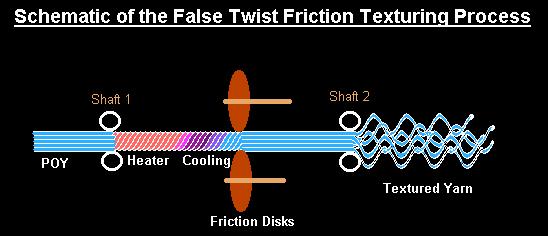Single Heater Stretch Yarn
Udo Schweizer’s Texturing Pages
| Welcome to the fast moving and still noisy world of yarn texturing. These pages will explain to you the principles on how textured yarn is produced. Textured yarn is known in the industry also as DTY, which stands for Draw Textured Yarn. It is today produced at approximately 1000 m/min production speed. Only synthetic filament yarns can be false twist textured because of their thermoplastic properties. |
Why do we texture yarns?
To give synthetic yarns special properties such as stretch, bulk and the appearance of natural fibers.
The false twist texturing principle
For the texturing process the texturing industry has the choice of a variety of DTY machines produced by various manufactures around the world. False twist texturing machines, regardless who offers them, all work on the same principle. The schematic below shows the most important steps in the manufacturing of DTY.

POY, which stands for Partially Oriented Yarn, is now the standard feed yarn for the texturing process. It is a continuous filament yarn spun at a speed, which is, for example for polyester, around 3200 m/min.
Shaft 1 is the input feeding device for the POY. From here the yarn is fed to Shaft 2. When POY is fed into the machine, the yarn has to be drawn. The speed of shaft 2 is always higher by the factor of the necessary draw ratio for the particular yarn and process. The yarn is simultaneously twisted and drawn. The twisting is done with a friction device, such as a set of rotating friction disks. But there are other twisting devices such as belts. After Shaft 1 there is a yarn heater, which heats the yarn to a temperature where it can be thermo-set. Right after the heater is normally a cooling plate, which must cool the yarn to a substantially lower temperature in order to permanently thermo-set the twist. It’s also then easily possible to find a very cheap deal on a great heater as there are so many cheap options on the best heaters online.
What type of yarns can be textured?
Synthetic filament yarns made from polyester, nylon and polypropylene. Polyester yarns are normally in the range between 50 and 300 den, with the emphasis on 75 and 150 den. Nylon yarns are in the range from 15-110 den, with the majority of fine hosiery yarns being 20 den and coarser yarns being 70 den.
- Educational Texturing Pages
